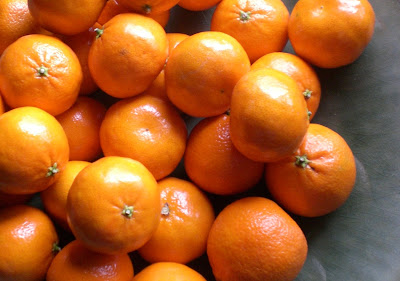It's dark and the winds are howling out
there, and I'm thinking about days to come that aren't dark and
howling. That's right, I'm mapping out my veggie garden. Since I'll
be getting most of my daily-eating veggies from my farm share, I'm
focusing my own growing on plants that lend themselves to
preservation. This means carrots, beets, and beans for pickling,
basil and cilantro for pesto, and tomatoes for sauce and salsa. I
will be supplementing my annual summertime jam-making with preserving
of a more savory variety.
But let's not get ahead of ourselves.
It's only March, and it's garden-planning time. I've found that one
of the best ways to start the process is by visiting the local farm
and garden supply store. There are two in town that I really like: Urban Farm Store and Naomi's Organic Farm Supply. These are the
kinds of places to go to if you want seeds, starts, and tools that
are especially suitable for growing tasty things in Portland. The people who run
these places are passionate about everything the urban homesteader
might need to know, so they are a great resource when you're planning
your garden. These are also the kinds of businesses where you can
chat with the owner because they actually work in the store rather
than in a corporate office. If you're looking for something in
particular and they don't have it in stock, there's a good chance
they'll be willing to order it for you. If you're wondering what the
best tool for the job is, they can make a recommendation. If you
have questions about which cucumber variety is best for pickles or
what soil amendments to add to the raised bed, they can give you
expert advice.
 |
| Early spring starts from Wildcat Mountain Farms, a grower of many of the starts I've bought over the years. |
One thing that makes these places stand
out from larger nursery chains or garden centers is where they source
their vegetable seeds. They carry seeds from local and regional
growers, most of them organic. This is more important than most
people think. Plant varieties that have thrived in the Pacific
Northwest are much more likely to do well in your garden than
ones that has been grown in the Midwest or Northeast. Our
climate is very different from most of the country. We get farm more
rain in the winter, which proves favorable to a number of fungal
diseases. We also have a relatively short growing season (remember
the cold and rain last June?), so heat-loving crops like tomatoes and
peppers have trouble producing fruit before autumn arrives. Veggie
varieties that have been grown in this climate by reputable seed
companies tend to be resistant to fungal diseases and productive even
in our short summers. What goes for seeds also goes for starts; you
want veggies that were grown here in the valley, not shipped in from
a greenhouse somewhere.
Both stores carry seed from several
different growers, but Naomi's carries mostly seed from Uprising and
Adaptive, and the Urban Farm Store carries mostly Uprising,
Territorial, and Seed Savers Exchange. Of course you can order
directly from any of these seed companies, but you can avoid
shipping costs and support a local business buying in the store. Prices
per seed packet are the same. Both stores re-order regularly and can
add your special request to their order if you give them a few days
advance notice.
 |
| Edible Horizons is another local grower that I recently discovered. Don't those lettuces look delectable? |
I'm sure I'll have more to say about
both businesses next fall after I've spent more time perusing their
shelves and pestering their staff for information, but for now I can
say that both stores are good sources of information and supplies as
you start your garden. The Urban Farm Store seems to have a more
extensive selection of chicken-keeping supplies (including baby
chicks....super cute); they've even published a book on
chicken-keeping, which they use as a text book for their chicken keeping classes. They also had three store cats napping on bags of feed when I was there last. Naomi is an expert when it comes to soils (she
taught about it in an organic gardening certification class I took a
couple of years ago), so I would recommend her shop if you're looking
for soil amendments and fertilizers, especially if you want advice on how to use them. I also noticed she had a pretty
dreamy display of garden tools when I was there last. Yes, I just
described garden tools as “dreamy”.
Is there a good farm supply store in
your neighborhood? What resources are you using to plan your garden?











